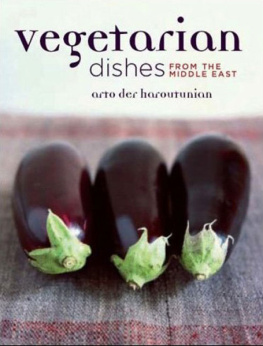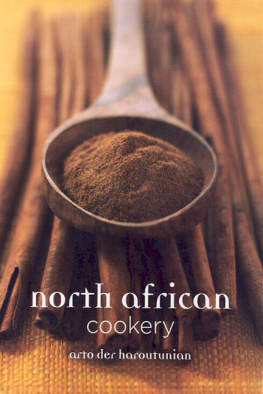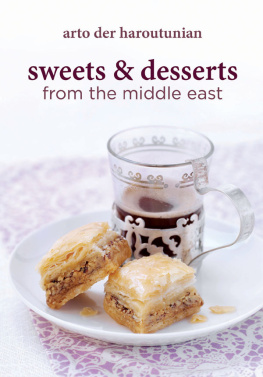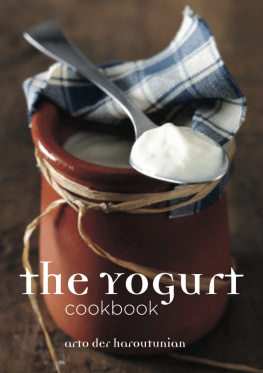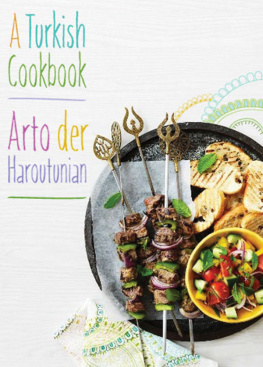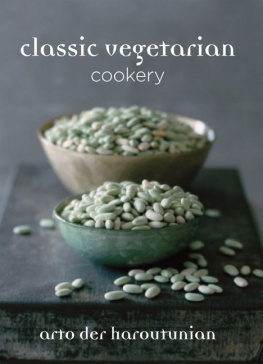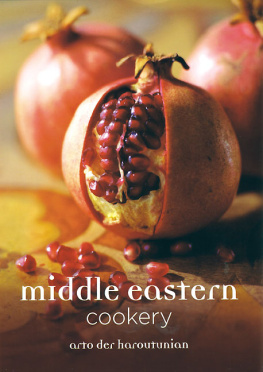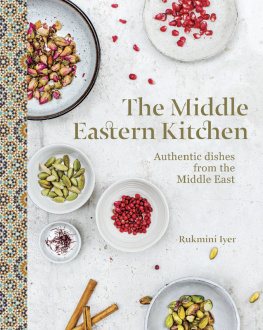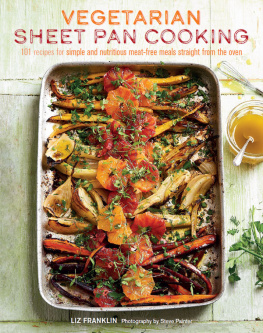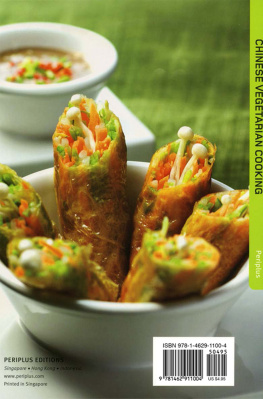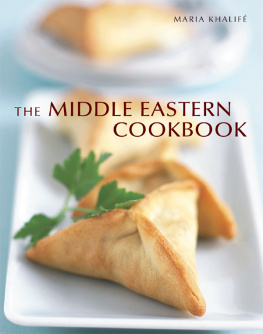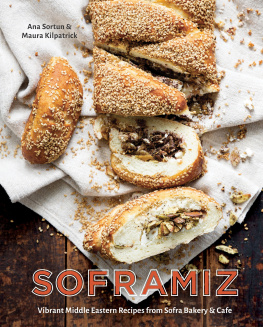
Published in 2008 by
Grub Street, 4 Rainham Close, London SW11 6SS
email:
www.grubstreet.co.uk
Text copyright Arto der Haroutunian 1983, 2008
Copyright this edition Grub Street, 2008
Design by Lizzie B Design
First published in Great Britain in 1983
by Century Publishing Co. Ltd
ISBN 9781902304816
EPUB ISBN: 9781909166646
A CIP catalogue for this book is available from the British Library
All rights reserved. No part of this publication may be reproduced, stored in a retrieval
system or transmitted in any form or by any means electronic, mechanical,
photocopying, recording or otherwise without the prior permission of the publisher
Printed and bound by MPG Ltd, Bodmin, Cornwall
This book is printed on FSC (Forest Stewardship Council) paper
Acknowledgements
Poems from the Book of 1001 Nights are taken from R.J. Burtons translation of 1885. For Sidgi Effendi, see Mal-ja-ot-Tabahin (Cairo, 1886). The lines from Mahmoud Darwish are from The Music of Human Flesh, translated by Denys Johnson-Davis (Heinemann, 1980); Armenian Folksong from Anthology of Armenian Poetry ed. D.D. Hovanessian (CUP, New York, 1978); the anecdotes were translated and edited from various late 19th-century and early 20th-century Turkish and Armenian periodicals.
Note: Unless otherwise stated, the recipes serve 46 people. Ideally, Middle Eastern dishes should be combined according to taste and the occasion.
contents

introduction
When frying an aubergine be gentle. Ask its permission first, then thank the Lord.
Armenian saying

The Middle East, the cradle of our Western civilisation, has not only been the centre of three major world religions, the foundation stone of great empires and the birthplace of many of historys greatest men, but also the major source of much of our Western culture. It was on the slopes of what is now Kurdistan that man first succeeded in cultivating wheat and barley 810,000 years ago. It was in Mesopotamia and Asia Minor (modern Turkey) where animals were first domesticated and where man built his first crude shelter, to be followed by fortified cities, communities, law, order and literature. One of the least-known and appreciated achievements of the Middle Eastern people has been in the field of food cultivation or, in present day technological jargon, food culture.
Innumerable tribes, races and nations have appeared on the podia of history, acted out their roles and then returned into the void of time, only to be followed by others who have retrieved their predecessors mantle and assured the evolution of history. Thus, down the ages have come (only to go in their turn) the peoples of the Pharaohs, Sumerians, Assyrians, Hebrews, Hittites, Babylonians, Urartians, Phoenicians, Greeks and Romans.
The people of the Middle East today, who regard themselves as Arabs, Armenians, Iranians, Kurds, Jews or Turks are, in essence, the descendants of those people of the past. They have retained the basic cultures of their ancestors almost intact although their own ancestry is often hidden in self-perpetuating shrouds of mystery and romance. A brief study of their cultures, be it of food, mythology, art or applied sciences, will illustrate clearly the contention that the people of the Middle East are virtually with a very few exceptions of the same ancestry and culture, and their food is part of that same culture.
Time was when a handful of daring and eccentric Europeans one had to be eccentric to be daring in those days dressed as Arabs or, acting as missionaries or archeologists, traversed the dunes of Arabia, plundered their way through Asia Minor or descended into the valleys of Kurdistan in search of knowledge and excitement or in pursuit of personal achievement or enlightenment. On their return they brought with them smatterings of half-truths, hearsay and mumbo-jumbo; ideas picked from the corners of the souks or from the hot, sweaty chambers of partly ruined Turkish baths. To them, and to most other Westerners, the Middle East was and in some ways still is the mysterious Orient.
Yet there was never anything mysterious about the Middle East. The mystery was in the eyes and minds of the foreign beholders! Little was and still is known about the food of this region; only in recent years has the average European or American heard of such Middle Eastern specialities as kebabs, yoghurt, stuffed vegetables and sheeps eyes! But one of the most interesting (dare one say exciting) contributions to the culinary culture of the world is still hardly known or appreciated: I refer, or course, to the Middle Eastern art of vegetable cooking.
The people of the Middle East are in essence vegetarians; meat, poultry or fish are really extras to their basic diet of cereals, pulses, dairy produce and vegetables. Over the centuries, versatile, rich and often ritualistic methods of vegetable cooking have evolved; for both to the men of the desert and those on the hills, a little had to go a long way and this meant careful husbandry, clever use of what was available, relatively imperishable and even edible. There is such a thing as Middle Eastern cuisine, as there is Indian, Chinese or European cuisine, yet this can be subdivided by taking into account certain religious, geographic and ethnic differences. Nevertheless, there is an overall uniformity in approach, preparation and presentation.
The first obvious characteristic of the regions cooking in general and vegetarian cooking in particular is its innate simplicity. The nomadic tribesmen or the peasants in their mud-baked shelters were not interested in, nor could they afford to create, haute cuisine. Theirs is a simple, honest type of food without pretensions or ornamentation. Simplicity, however, does not imply monotony thanks to the many spices and herbs available to give flavour and character to the main ingredients used.
The Middle East is fortunate in these spices. Because of its geographical position, the people of the Middle East have for centuries been the middlemen in trade transactions between the Far Eastern lands and Europe. Through Arabia, Persia and Anatolia passed the caravans carrying carpets, silk, jewellery and spices; indeed virtually everything that came to Europe prior to the discovery of the route to India via the Cape of Good Hope, passed through the Middle East.
Another important characteristic is the method of preparing vegetables. No self-respecting housewife will just boil her vegetables; they will be fried in olive oil or butter first. If the vegetables are to be served cold, they will be cooked in oil as this does not congeal when cold. Vegetables prepared in this way make excellent appetisers, salads or side dishes. Cooking with olive oil is most common along the Mediterranean coastline and has been known there for millennia. Butter or ghee dishes are more popular in Iran, Iraq, the Caucasus and the desert lands, where olives are not readily available. Here, the vegetables are fried, stewed, grilled, baked or stuffed with other vegetables; they are pickled, used in salads and also made into delicious sweets and preserves.
Vegetables such as onions, leeks, spinach, beans, tomatoes and cucumbers are all well known and used by European and American housewives, but there are certain others which, although they have entered Western cuisines in recent years, are still best exploited by the people of the Middle East. For example:
a) The aubergine
Next page
